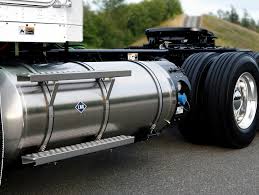By Kasia McBride, Marketing Manager, NGVi
According to research done by Frost & Sullivan, by 2017, approximately 8% of new North American class 6-8 trucks will be powered by natural gas. While compressed natural gas (CNG) vehicles represent the largest number of natural gas vehicles (NGVs) on the road, for certain applications where vehicle weight, repetitive travel, and long-distance routes are critical, utilizing liquefied natural gas (LNG) may be the perfect choice for heavy-duty fleets.
With the expected increase of LNG trucks on the road, maintenance technicians who will service and repair these vehicles must be adequately trained on the properties and characteristics of the fuel itself as well as on the best safety practices for LNG vehicles and maintenance facility operations.
LNG is natural gas that has been cooled to the point that it condenses into a liquid. This condensation occurs at a temperature of approximately -260゚F at atmospheric pressure, which reduces natural gas volume to 1/600 of its gaseous form. The high energy density of LNG allows more fuel to be stored onboard the vehicle and therefore increases the vehicle’s driving range, making it an ideal choice for long-haul trucks.
When we refer to an LNG vehicle, we are describing only the onboard fuel storage strategy—the engine powering the vehicle actually operates on natural gas in its gaseous state. Once LNG leaves the onboard fuel storage system, it is warmed and becomes a gaseous fuel. This warming process starts in the LNG tank as the fuel absorbs the latent heat and then continues after the LNG leaves the tank and enters a component called a heat exchanger. Once the fuel reaches a temperature of -160゚F it is fully vaporized.
There are two primary reasons why the engine would not run on natural gas in its liquid form. First, an internal combustion engine operates on the principal of compressing a gaseous fuel. Because the liquid put into an engine cannot be compressed, the engine would not rotate. Second, natural gas is only flammable when the fuel concentration in air is roughly between 5% and 15%. Because liquefied natural gas is 100% fuel concentration, it cannot mix with air until it changes its state to a vapor form.
LNG Safety
There are four major distinctions between LNG and CNG, with respect to safety.
First, while CNG is lighter than air, LNG, depending on its temperature, can be either heavier or lighter than air. A large leak of LNG will pool on the ground and as it begins to warm, it will vaporize and dissipate upward. Because of this, maintenance facilities where LNG vehicles will be serviced need to be modified to accommodate natural gas in both states: heavier and lighter than air.
Another important safety related difference is that CNG is odorized, allowing for human leak detection. In a vehicle maintenance facility, technicians would normally be able to detect the smell of CNG long before dangerous levels of the fuel accumulate. These same technicians would not be able to detect LNG because it is an odorless fuel. Odorant cannot be added to LNG because the severely low temperature at which it is stored would cause the odorant to freeze.
Technicians would not be aware of an LNG leak unless they happened to see or hear evidence of one. Since vehicle maintenance facilities are typically busy, noisy places, and stopping service or repair activity to listen for a LNG leak is neither safe nor practical. Therefore, proper vehicle maintenance facility modifications must be made before servicing or repairing these vehicles. This would include installation of methane detection systems interlocked to exhaust fans and other building systems.
Another LNG vehicle difference is the venting of the LNG tank. As the fuel changes state from a liquid to a vapor it expands its volume by 600 times. This causes the pressure inside the tank to increase significantly as this expansion is confined inside the LNG tank. For safety reasons, the tank is equipped with a pressure relief valve that opens at 230 psi to release the excess pressure, and then closes again once the pressure drops below 230 psi.
Finally, LNG is a cryogenic (extremely cold) liquid fuel and there is a potential hazard when it comes into contact with human skin. Because of this, fueling LNG vehicles requires the use of Personal Protective Equipment (PPE) including a face shield and safety glasses for double eye protection, cryogenic rated gloves, aprons and LNG compatible clothing and footwear. Technicians who repair or work with the LNG components of the vehicle will need to either defuel the LNG components prior to performing maintenance and/or repair, or wear proper PPE.
There is no doubt that the use of LNG is growing among long-haul fleets. The low cost of the fuel multiplied by the tough-duty routes and long engine hours make this fuel a very favorable option for heavy-duty trucks. Whether running on CNG and LNG, operation of the engine is the same.
Significant differences between the two systems such as fuel storage method, extreme temperature or pressure, properties of the chosen fuel, and the addition of a heat exchanger for LNG, means that technicians need to be fully familiar with the unique characteristics of both the fuel system and the fuel. When it comes to LNG, specialized training and following proper procedures will help ensure the safety of your technicians, as well as fleet and vehicle maintenance facility operations.


